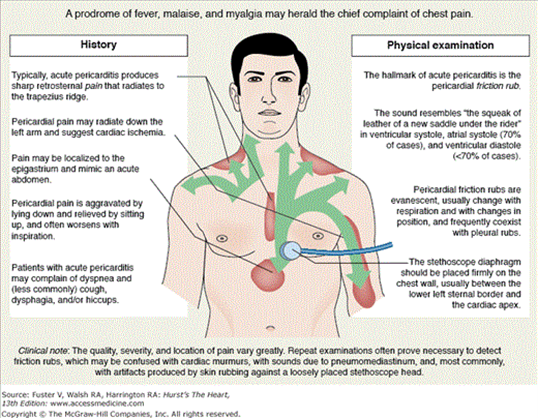A nurse is assessing a client who has pericarditis.
In which of the following areas of the client's chest should the nurse place the stethoscope to best hear a pericardial friction rub? (You will find hot spots to select in the artwork below.
Select only the hot spot that corresponds to your answer.).
A
B
C
D
The Correct Answer is {"xRanges":[101.765625,141.765625],"yRanges":[263.609375,303.609375]}
A pericardial friction rub is highly specific for acute pericarditis and is generally heard over the left sternal border.
It is often louder at inspiration but sometimes can be better heard on forced expiration while the patient bends forward.
Choice A is not the answer because it does not correspond to the left sternal border.
Choice B is not the answer because it does not correspond to the left sternal border.
Choice D is not the answer because it does not correspond to the left sternal border.

Nursing Test Bank
Naxlex Comprehensive Predictor Exams
Related Questions
Correct Answer is A
Explanation
Acupuncture is commonly used to treat a wide range of illnesses and ailments including pain management, control of nausea and vomiting, fatigue, hot flashes, xerostomia, neuropathy, anxiety, depression, and sleep disturbance in cancer patients.
However, I could not find any information that suggests mouth sores (B), headaches, or urticaria (D) are contraindications for acupuncture.
Lymphedema is a contraindication for acupuncture because it can increase the risk of infection in the affected area.
It is important for the nurse to identify this as a contraindication to receiving acupuncture therapy.

Correct Answer is B
Explanation
The correct answer is: b. “I apply a lubricating lotion to the cracked areas on the soles of my feet every morning.”
Choice A reason: Elevating the feet for long periods is not generally recommended for clients with Peripheral Arterial Disease (PAD). This is because elevation can decrease arterial blood flow to the feet, which is already compromised in PAD. The goal is to promote blood flow to the extremities, and elevation might work against this, especially if done for extended periods.
Choice B reason: Applying a lubricating lotion to the feet, particularly on the soles where the skin can become very dry and cracked, is beneficial for someone with PAD. It helps to maintain skin integrity and prevent skin breakdown, which can lead to serious complications due to the reduced blood flow and healing capacity in PAD.
Choice C reason: Soaking the feet in hot water is not advisable for individuals with PAD. They may have reduced sensation in their feet due to poor circulation, which increases the risk of burns from hot water. Additionally, prolonged soaking can lead to maceration of the skin, making it more susceptible to injury and infection.
Choice D reason: Using a heating pad, even on a low setting, to keep the feet warm is risky for clients with PAD. Due to decreased sensation from poor circulation, there is a danger of burns because the client may not feel how hot the heating pad is. It’s better to wear warm socks or use room temperature control to keep the feet warm.

Whether you are a student looking to ace your exams or a practicing nurse seeking to enhance your expertise , our nursing education contents will empower you with the confidence and competence to make a difference in the lives of patients and become a respected leader in the healthcare field.
Visit Naxlex, invest in your future and unlock endless possibilities with our unparalleled nursing education contents today
Report Wrong Answer on the Current Question
Do you disagree with the answer? If yes, what is your expected answer? Explain.
Kindly be descriptive with the issue you are facing.
